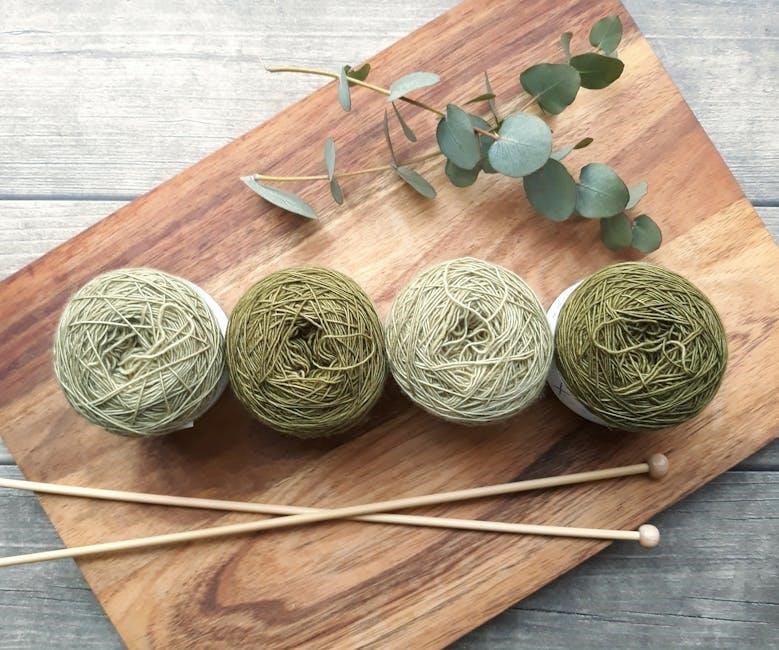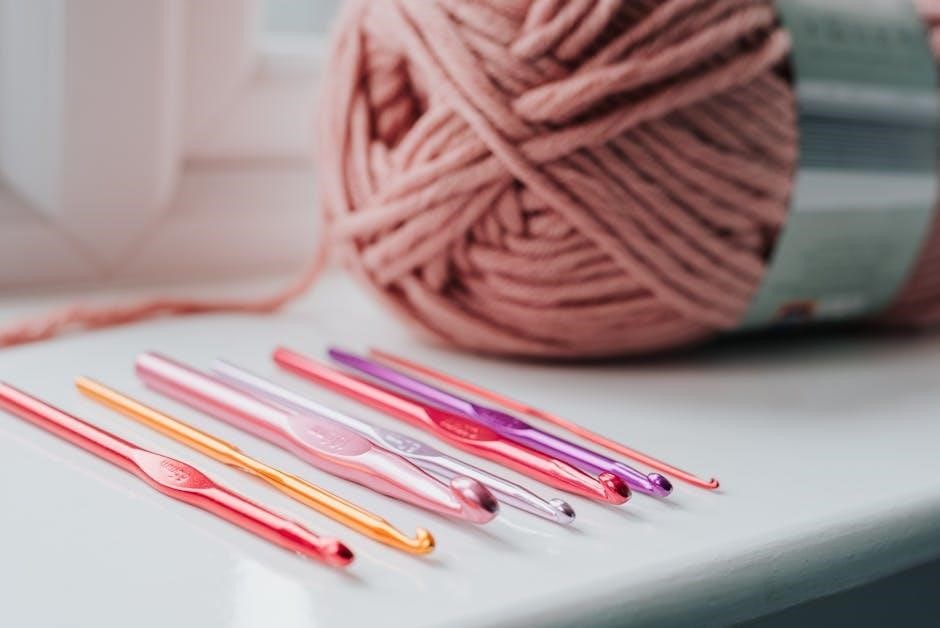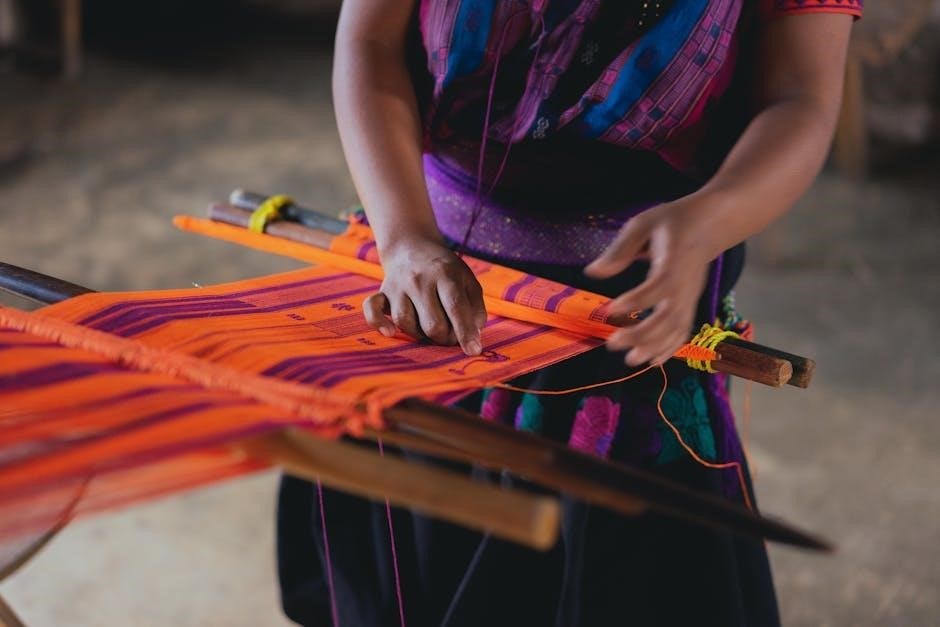Understanding Yarn Basics
Understanding yarn basics is essential for any crochet or knit project. It involves knowing different fibers, weights, and maintaining proper tension. Always swatch to ensure accuracy.
Overview of Yarn Types and Fibers
Yarns come in a variety of types and fibers, each with unique properties. Natural fibers like wool, cotton, and silk are popular for their breathability and softness. Wool is warm and durable, while cotton is lightweight and absorbent. Synthetic fibers, such as acrylic and polyester, are versatile, easy to care for, and often more affordable. Blends combine natural and synthetic fibers to enhance performance. For example, acrylic-wool blends offer warmth and softness with good stitch definition. Specialty fibers like bamboo and linen are eco-friendly and provide distinct textures. Understanding the characteristics of each yarn type helps in selecting the right one for specific projects, ensuring the desired texture, drape, and durability. This knowledge is crucial for achieving the best results in knitting or crocheting.
Importance of Yarn Weight and Gauge
Yarn weight and gauge are critical factors in knitting or crocheting. Yarn weight refers to its thickness, categorized from superfine to bulky, affecting the project’s drape and warmth. Gauge measures stitches per inch, ensuring the finished item fits as intended. Incorrect gauge can lead to garments that are too tight or too loose. Yarn weight and gauge are often specified in patterns, so matching them ensures proper fabric density and texture. Always swatch to verify gauge, as it varies with yarn weight and needle size. Using the wrong yarn weight can result in a project that doesn’t meet expectations. Understanding these concepts helps crafters achieve professional-looking results and ensures their time and effort yield the desired outcome.

Selecting the Right Yarn
Selecting the right yarn involves considering fiber type, weight, color, budget, and care instructions to ensure the best texture and durability for your project.

How to Choose Yarn Based on Project Needs
Choosing the right yarn for your project involves considering the type of fiber, weight, color, and care instructions. Different fibers like wool, cotton, and acrylic offer unique properties. Thicker yarns are ideal for quick, warm projects, while thinner yarns suit detailed work. Select colors that match your desired aesthetic. Budget is also a key factor—balance quality and cost. Always check care instructions to ensure the yarn suits your needs. For example, wool is great for warmth but may require hand washing. By aligning these elements with your project goals, you can achieve the desired texture and durability.
Understanding Yarn Labels and Terminology
Yarn labels provide essential information to guide your project. Key details include fiber content, weight category, gauge, yardage, and care instructions. Fiber content determines softness, durability, and care needs. Weight refers to yarn thickness, ranging from lace to bulky. Gauge indicates stitches per inch, crucial for sizing. Yardage tells you how much yarn is available. Care symbols explain washing and drying methods. Common terms like “worsted weight” or “DK” describe specific yarn weights. Understanding these elements ensures you select the right yarn for your project needs. Always check labels to match your pattern requirements and achieve the desired result. This knowledge helps you make informed decisions and avoid project mismatches.
Working with Yarn
Working with yarn requires attention to swatching, tension, and substitution. Swatching ensures proper fit and gauge. Maintaining even tension prevents uneven stitches. Yarn substitution should match fiber and weight for desired texture and durability.
The Importance of Swatching
Swatching is a crucial step in crochet and knitting that ensures your project meets the desired gauge and texture. It helps you understand how the yarn behaves and confirms that your hook or needle size is appropriate. A swatch allows you to see the drape of the fabric and how stitches will look in the finished piece. Without swatching, your project may end up too tight, too loose, or misshapen. It’s also a time-saver, as it prevents costly mistakes and the need to unravel completed work; By investing time in swatching, you ensure accuracy and achieve professional-looking results. This step is especially vital for garments and patterns where fit is critical.
Maintaining Proper Tension While Crocheting or Knitting
Maintaining Proper Tension While Crocheting or Knitting
Maintaining proper tension is vital for achieving consistent stitches in crochet and knitting. Tension refers to how tightly or loosely the yarn is held, which directly impacts the fabric’s texture and drape. If the tension is too tight, the fabric may become stiff and rigid, while too loose a tension can result in a flimsy or misshapen project. To maintain even tension, focus on holding the yarn consistently and not pulling it too hard or letting it go slack. Practice is key, as developing muscle memory helps in keeping a steady hand. It’s also important to stay relaxed while working, as tension in the hands can transfer to the yarn. Proper tension ensures your projects are even, professional-looking, and comfortable to wear or use.
Yarn Substitution Tips and Tricks
When substituting yarn, consider factors like fiber content, weight, and gauge to ensure compatibility with your project. Always check the yardage to ensure you have enough yarn. If swapping fibers, think about their properties—wool for warmth, cotton for breathability. Swatching is crucial to verify stitch tension and drape. Avoid mixing yarns with vastly different weights, as this can alter the project’s size and texture. For pattern-specific yarns, look for alternatives with similar stitch definition. If unsure, consult yarn substitution guides or online forums for recommendations. Proper substitution ensures your project meets the desired aesthetic and functionality, even when using a different yarn than specified.
Yarn Care and Maintenance
Proper yarn care ensures longevity and quality. Store yarn in a cool, dry place, away from direct sunlight and pests. Avoid harsh handling to prevent splitting or tangling.
How to Wash and Dry Different Types of Yarn
Washing and drying yarn require careful attention to preserve its quality and texture. For most yarns, hand washing in cold water with mild detergent is recommended. Avoid machine washing unless specified. Gently swish the yarn in water, then rinse thoroughly. For wool, use a detergent designed for wool to prevent felting. Cotton and acrylic yarns can usually tolerate machine washing on a gentle cycle. Reshape items while wet to maintain their form. Air-dry by laying flat or hanging, depending on the fiber type. Avoid direct sunlight, as it may fade colors. Proper drying ensures yarn retains its softness and structure for future projects.

Storing Yarn Properly to Prevent Damage
Proper yarn storage is crucial to maintain its quality and prevent damage. Store yarn in a cool, dry place away from direct sunlight and moisture. Avoid basements or attics with humidity. Use breathable containers like canvas bags or paper boxes to allow airflow, preventing mold and mildew. Keep yarn away from pests by sealing containers tightly. For long-term storage, wind yarn into balls or cakes and place in airtight bags. Label each container with fiber type and weight for easy identification. Do not store yarn in plastic bags, as they trap moisture. Regularly inspect stored yarn for signs of damage or pests. Proper storage ensures yarn remains fresh and ready for future projects.

Yarn and Crochet/Knit Projects
Yarn and crochet/knit projects are perfect for creating unique, personalized items. Choose the right yarn and pattern to ensure a successful, enjoyable crafting experience every time.
How to Match Yarn to Your Crochet or Knit Pattern
Matching yarn to your crochet or knit pattern is crucial for achieving the desired result. Start by considering the pattern’s yarn weight, fiber content, and color recommendations. Yarn weight affects the project’s drape and durability, while fiber content impacts softness, warmth, and care instructions. Always check the pattern’s gauge requirements and ensure your yarn choice aligns with it. Read yarn labels carefully for specific details like yardage, recommended needle or hook size, and care instructions. Swatching is essential to confirm that your yarn choice will produce the correct tension and fabric type. If substituting yarn, choose one with similar properties to ensure the best outcome. Proper yarn matching ensures a professional finish and enhances your overall crafting experience.



